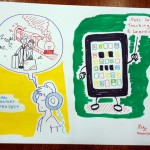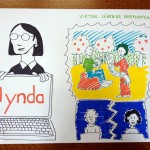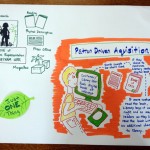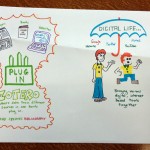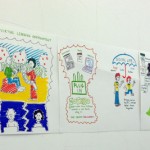For Part 1 of this series of blogs, The Foundations of Writing, click here!
For Part 2: Script, Lettering & Layout, click here!
For Part 3: Pencils, click here!
So here I am, in the midst of creating the 93rd Lucy the Octopus strip.
 Having completed the pencils (see above) and while the paper is still stuck with masking tape on to my drawing board, I get out my inking tools. These consist of permanent ink black drawing pens in a range of sizes:
Having completed the pencils (see above) and while the paper is still stuck with masking tape on to my drawing board, I get out my inking tools. These consist of permanent ink black drawing pens in a range of sizes:
Fine line drawing pens, either Staedtler Pigment Liners or Uni Pin Fine Lines with the following tip sizes: 0.8, 0.5, 0.3, 0.2, 0.1
Sharpie markers: Fine point and Chisel Tip
Set Square I don’t recall ever using a ruler to ink something in the Lucy strip. The only perfectly straight edges are the panel borders which I draw out in 0.5 pen using the horizontal bar of the drawing board and a set square.
I don’t recall ever using a ruler to ink something in the Lucy strip. The only perfectly straight edges are the panel borders which I draw out in 0.5 pen using the horizontal bar of the drawing board and a set square.
I leave the last panel without a frame to aid with the feeling of Lucy and Kate being lost and vulnerable.
Prior to that I inked the lettering for the KERLANK sound effect to avoid that over lapping with my panel borders. Next up, I free the paper from the shackles of the masking tape! This gives me the option to rotate the paper as I ink to reach the most comfortable position for drawing each line and curve. This is even more important when I use a brush to ink as oppose to pens (which I’ve done a few Lucy strips requiring a different style, as well as lots of other work).
Next up, I free the paper from the shackles of the masking tape! This gives me the option to rotate the paper as I ink to reach the most comfortable position for drawing each line and curve. This is even more important when I use a brush to ink as oppose to pens (which I’ve done a few Lucy strips requiring a different style, as well as lots of other work).
Sometimes ‘ll stay at my drawing board to ink, but often I’ll sit with my knees up and a couple of old sketch books to lean on. It’s not essential but preferable to ink facing a black and white cat a few feet away. Before I get on to the real art, I draw out the speech bubbles in a 0.5 line.
Before I get on to the real art, I draw out the speech bubbles in a 0.5 line.
You can see below how it looks easier to draw a curve when you can adjust the paper to a comfortable angle (but I still mess it up)! That little arrow I draw is to remind me to fix the mistake with the speech bubble after I scan the work into my Mac (ready to colour on Photoshop). It’s quicker to do this than to use tippex or opaque white paint on the actual paper.
That little arrow I draw is to remind me to fix the mistake with the speech bubble after I scan the work into my Mac (ready to colour on Photoshop). It’s quicker to do this than to use tippex or opaque white paint on the actual paper.
I’d wondered if I was the only inker to do this but I saw that when Mike Medaglia did some art for Tempo Lush Tales, he’d also done little arrows to show him where to fix things up on the computer. Maybe lots of folk do it!
Inking is an opportunity to look at the pencils with fresh eyes and make tweaks and improvements to the composition. With this in mind, I add an extra A at the beginning of the scream in Panel 3.
Not sure if it’s a bit of a faux pas inking the signature before completing everything else, but I do it anyway, because nobody tells Richy how to roll and I’m a complete badass. On to inking the actual drawing. Sometimes I do this panel by panel. More usually I approach the strip as a whole and work from the thickest pens down the to the finest. This saves a bit of time by not stopping to change pens so often.
On to inking the actual drawing. Sometimes I do this panel by panel. More usually I approach the strip as a whole and work from the thickest pens down the to the finest. This saves a bit of time by not stopping to change pens so often.
So I start with the fine point Sharpie and do the character’s eyes. No need for Chisel tip Sharpie today. A good rule of thumb is draw things in the foreground in a thicker line than things behind in a picture. That’s why I tackle Mrs Faridani in 0.8 line and will do the passengers behind her with a thinner pen.
A good rule of thumb is draw things in the foreground in a thicker line than things behind in a picture. That’s why I tackle Mrs Faridani in 0.8 line and will do the passengers behind her with a thinner pen.
 I also use the thicker line of the 0.8 pen to give the feeling of weight under elements such as the underside of the monster in Panel 2 and the handle in Panel 4.
I also use the thicker line of the 0.8 pen to give the feeling of weight under elements such as the underside of the monster in Panel 2 and the handle in Panel 4.  I finish with the 0.8 pen and start with the 0.5.
I finish with the 0.8 pen and start with the 0.5. I continue to work on the first 3 panels…
I continue to work on the first 3 panels… …until the 0.5 line work is done.
…until the 0.5 line work is done. I switch to the 0.3 pen to work on finer lines, including characters further towards the background.
I switch to the 0.3 pen to work on finer lines, including characters further towards the background. Finally I use 0.2 and 0.1 pens for the finest details, like the tiny passengers in Panels 2 & 5 and the characters in the deepest depths of the background of Panel 1.
Finally I use 0.2 and 0.1 pens for the finest details, like the tiny passengers in Panels 2 & 5 and the characters in the deepest depths of the background of Panel 1. The drawing part of the process is complete!
The drawing part of the process is complete!
Join me next time for a thrilling look into… erasing the pencil marks!
I may be overselling this.
For Part 1 of this series of blogs, The Foundations of Writing, click here!
For Part 2: Script, Lettering & Layout, click here!
For Part 3: Pencils, click here!
For Part 5: Erasing, Scanning & Cleaning Up click here!
For Part 6: Colours click here!
For a video overview click here!


